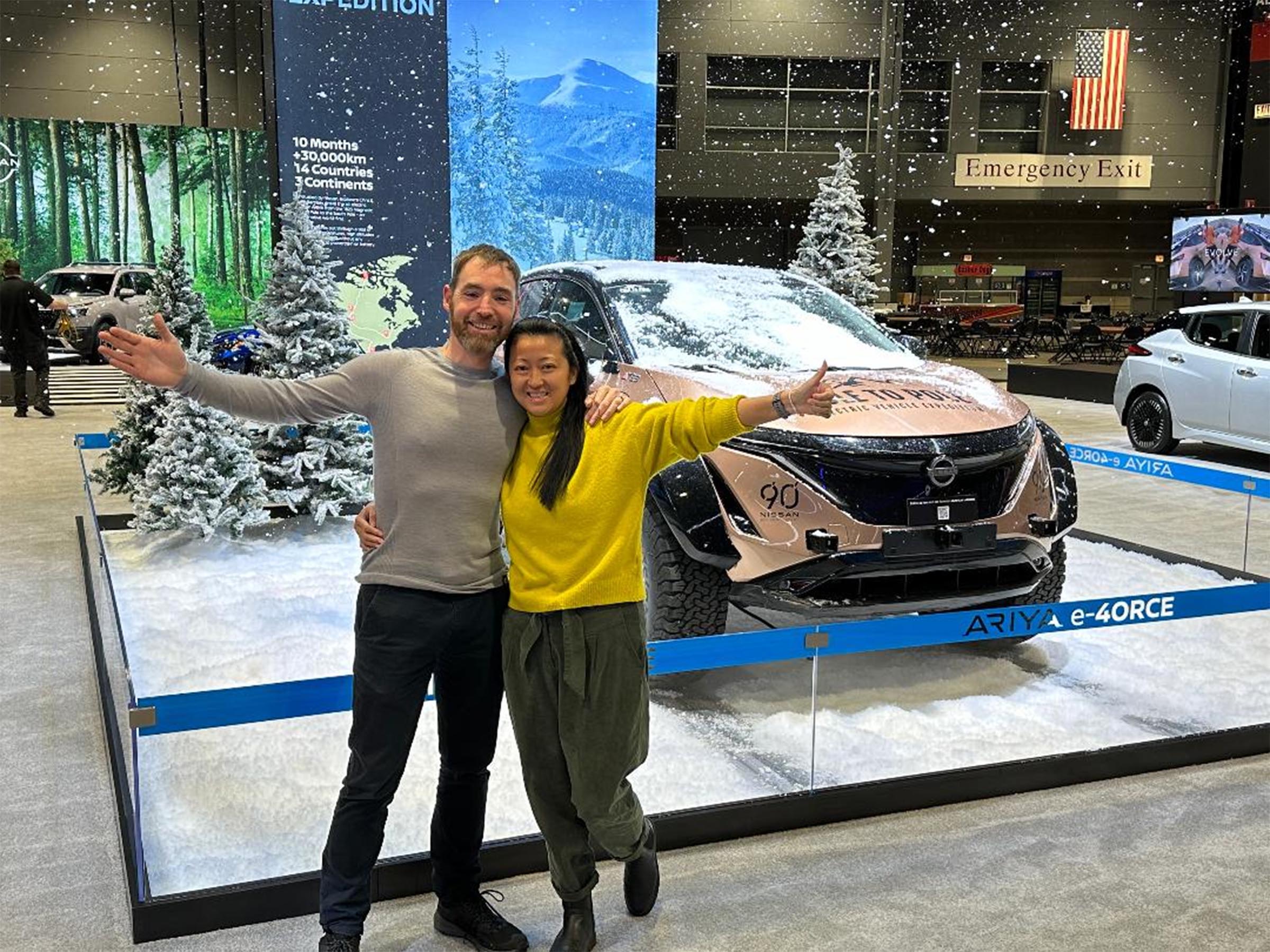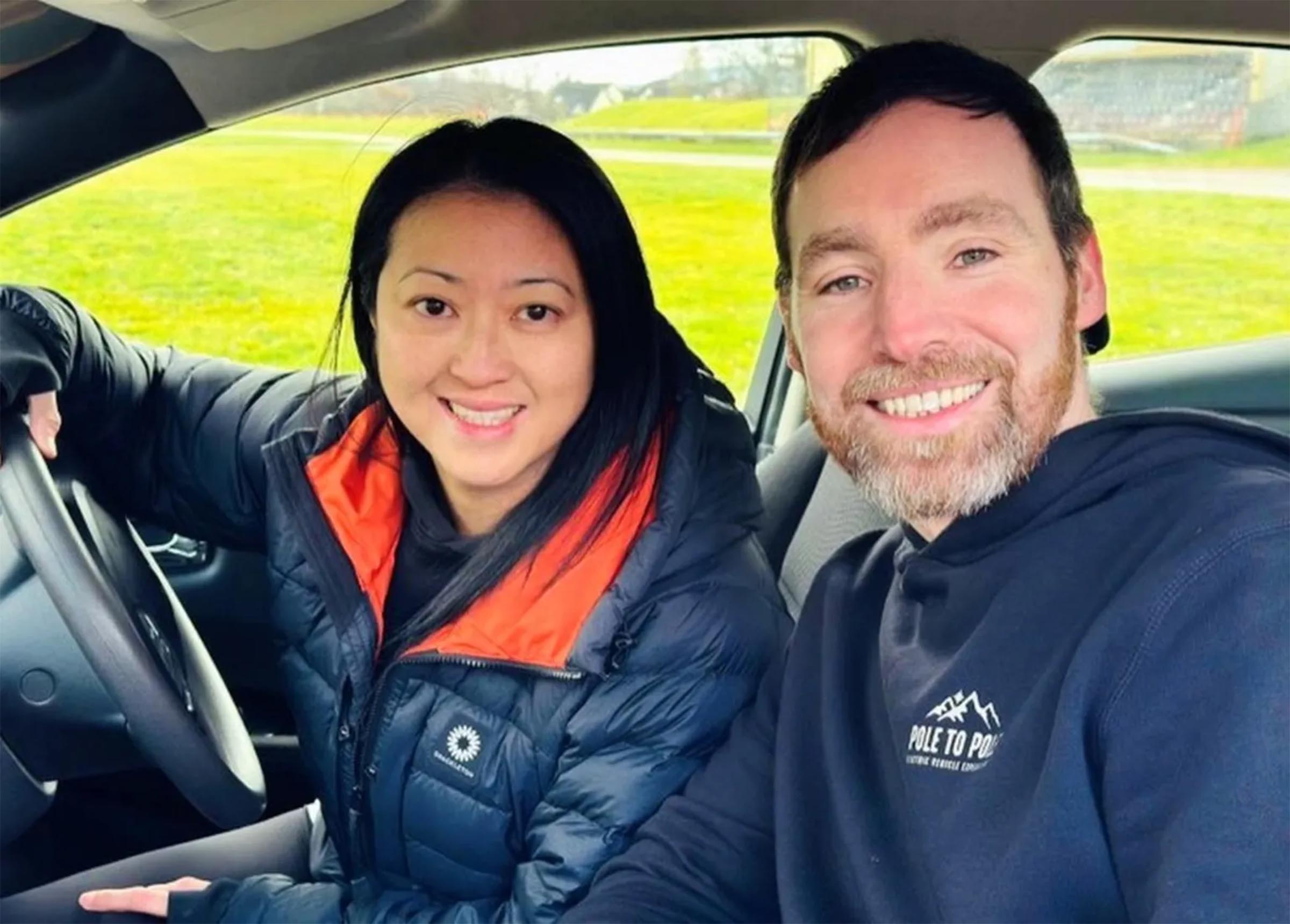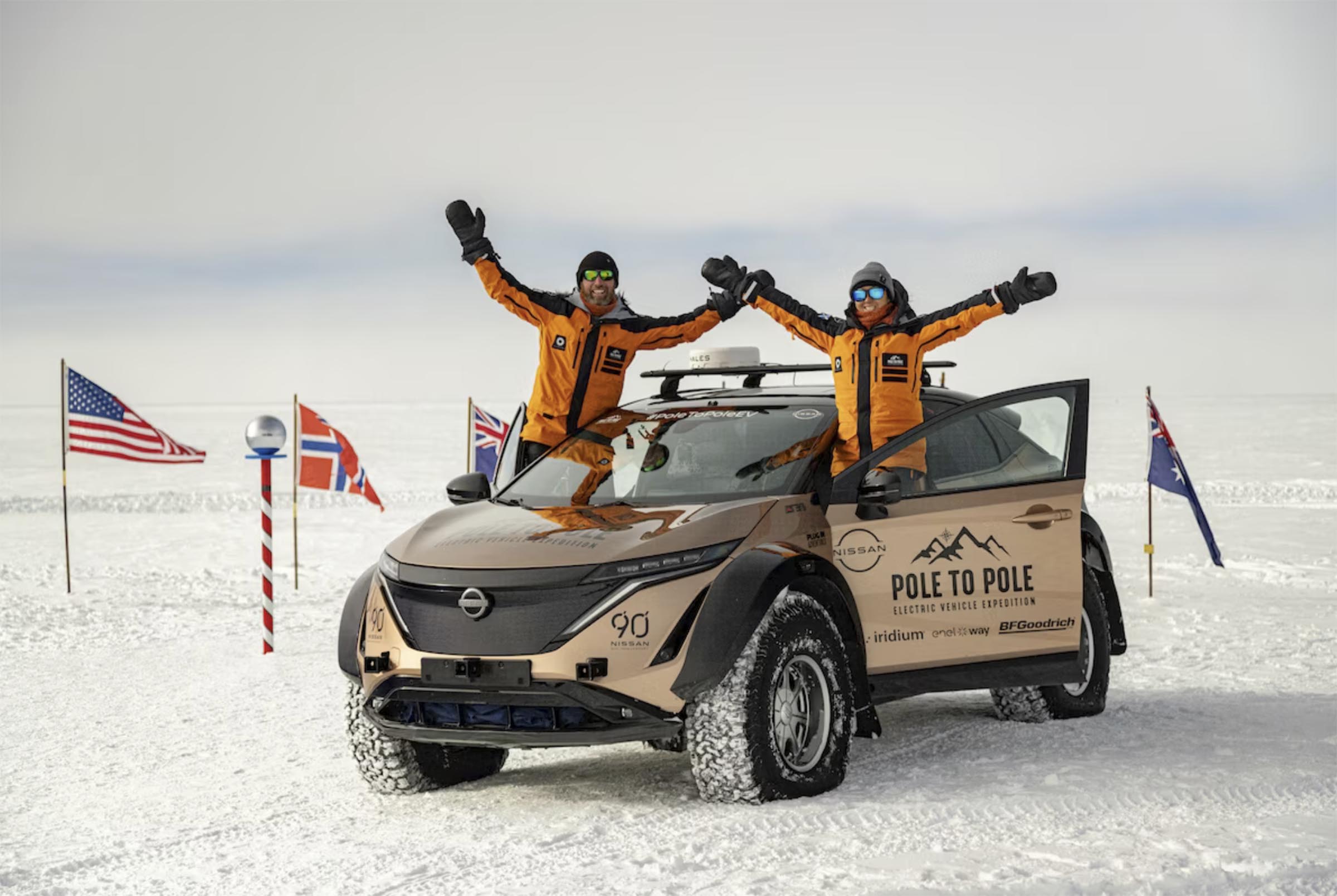Julie Ramsay had no idea what to expect when husband Chris Ramsey bought his first Nissan Leaf a decade ago — but the two quickly fell in love with EVs and, since then, have headed out on a series of adventures to test the limits of the technology and disprove many of the myths about battery technology. They first drove entirely around England, then took a 10,000-mile adventure to Mongolia. Their latest adventure set a new record, driving 22,000 miles over 10 months from the North to South poles.

Chris and Julie Ramsey celebrate the end of their 10-month journey alongside their Nissan Ariya at the Chicago Auto Show.
It was a grueling trip and a technically challenging one, Chris and Julie Ramsey told Headlight.News when we caught up with them at the Chicago Auto Show — where their Nissan Ariya e-4orce is on display.
We asked them what it was like facing the most extreme climates on Planet Earth — and the places they traveled in-between. The Ramseys also offered a hint of future adventures to follow.
Headlight.News: You’ve been EV fans for a while.
Chris Ramsey: We’ve been an EV household for a decade. I discovered a 24-kWh Nissan Leaf and took it on a 1,600-mile journey around the UK. We had a few challenges as there were only about 60 chargers in the whole country. I came off the trip and said, “I love it.”
Jim Ramsey: Like most people I was nervous at the beginning. But we discovered, yeah, EVs are for us.
HLN: You did the 1,600-mile run, but you went deeper down that rabbit hole.
Chris: We did, indeed. We did a few more mad, crazy road trips and in 2017 I convinced Julie to join me on the Mongol Rally, to drive from London to Mongolia
Julie: It was a 30 kWh Nissan Leaf with a range of 90 miles. So it was 111 charges. And that’s the beauty of it, 111 stories, because each time you charge you connect with people.

By the poles, the temperature dropped as low as minus 39 degrees — before windchill. In the Arizona desert it reached 120 degrees.
HLN: Most people would have said, “I can’t believe I did that and stop. You said, “Let’s do something really absurd.”
Chris: You’re getting a feeling my brain is a little bit different. Then I thought, how can we push things further? How can we test the technology and innovate even more? How do we debunk all those (EV) myths – that they don’t work in the cold or in hot climates, or that they can’t go long distances? I got to thinking about going pole-to-pole. Nobody’s done that before, no car, combustion or electric.
HLN: What did it take to convince you, Julie?
Julie: You have one life, one opportunity. We succeeded in the Mongol Rally when a lot of people didn’t think we would. So, it gave me the (sense), yeah, let’s do it.
More Nissan News
- Nissan Delaying Two U.S.-Made EVs — Again
- 2024 Nissan Versa Is the Cheapest New Car in America, But Is It Any Good?
- Nissan Hyper Tourer Concept: A Van That Really Cares

The Ramseys drove a Nissan Ariya e-4force that was only lightly modified. It needed only two repairs on its coast-to-coast journey — once when Chris Ramsey backed into a pole.
HLN: You did need some help yes?
Chris: We’ve never been to Arctic and Antarctic ourselves. We turned to Arctic Trucks (ED: an Iceland-based company that organizes polar trips) for support vehicles. They got it right away. And then we talked to Nissan (which) I’ve worked with on a number of projects. And they got it. (They wanted) to show people the capabilities.
HLN: And after prepping, you headed out. How long were you gone?
Julie: Ten months. We left (the magnetic North Pole) March 29 and reached the (South) Pole on the 15th of December 2023.
HLN: That was a long time on the road. Why did it take so long?
Chris: We needed to be up there (in the Arctic) when the ocean was frozen over and we needed to reach Antarctica in its summer, the only time you can do expeditions there.

The Ramseys used portable gas and wind generators to charge near the poles. In parts of South America they convinced partners to install EV chargers for the first time.
HLN: There had to be challenging moments between husband and wife.
Julie: We had a husband-and-wife debate, shall we say, in the car. Chris actually backed up into a pole when we were driving through Los Angeles.
HLN: What kept you going?
Julie: The importance of showing people how exciting and capable EVs are.
HLN: There had to be tougher times when you were at the Poles.
Chris: The coldest temperature we saw was minus 39 Celsius (ED: about -39 Fahrenheit), excluding wind chill. The hottest temperature, when we were in Arizona was 49 Celsius (ED: 120 F). That was a challenge more for us than the car. The car looked absolutely fine.

The Ramseys bundled up during a stop near the South Pole where temperatures were cold enough to freeze alcohol.
HLN: Other than hitting the pole, did you need any other major repairs or make any modifications to the car?
Chris: The main modification was 39-inch BF Goodrich tires that we could drop to anywhere from four to 10 psi to increase traction (on snow and ice). We added a skidplate underneath to protect the battery and everything. The only breakdown was in the Arctic when we had to launch the car through a deep snow. We crashed down on a big rock and it broke the steering rack. But the Arctic Truck folks had a spare and replaced it about 40 minutes.
HLN: Driving for 10 months had to be rough, just getting sleep?
Julie: It was constant, moving every day. We had to plan our charging stops, where to sleep, eat and wash our clothes. Our brains never stopped. It wasn’t easy. It was tough. Mentally tough, just concentrating on your driving because technique is very important on this type of expedition.
HLN: How did you charge along the way?
Chris: We brought along a 7 kW gas generator for use near the poles. There were no places to plug in. We also had a portable 5 kW wind generator. The whole point of this project was to develop, create and innovate.
Julie: We had partners in South America (ED: where there weren’t always chargers available). One partner used our project to convince businesses along the way to put in chargers.

While they may take a break to absorb — and talk about — the lessons learned traveling pole to pole, the Ramseys say they’re already thinking about their next adventure.
HLN: You’ve also said there were times people simply let you plug in at their homes and businesses.
Chris: It reaffirmed what we experienced on the Mongol Rally, that there’s kindness in the world. No matter where you are as human beings, people open their hearts. They open their doors and they just welcomed us.
HLN: I have a sneaking suspicion that you’re going to come up with yet another adventure.
Julie: It wouldn’t surprise me. His brain never stops ticking. But I think, now, we’re going to try and get some rest and share our story about how exciting EVs are.
Chris: Yeah, as Julie says, my brain never stops working. And there are lots of things; how can we push further? How can we demonstrate in an even more captivating and engaging way what EVs are capable of?



Thank you guys about Mongolians.